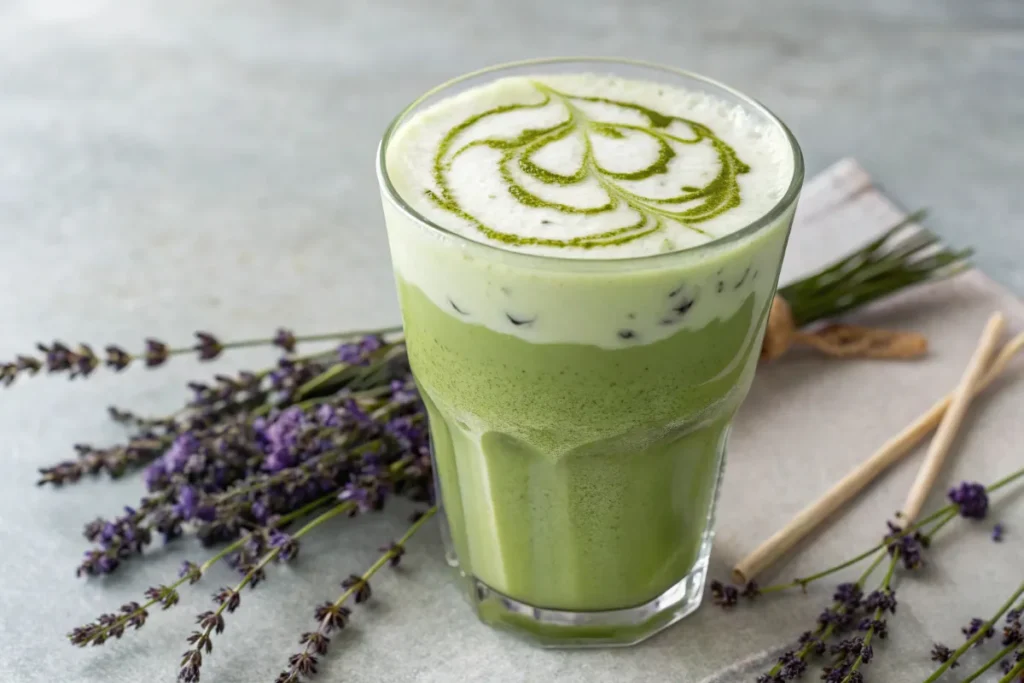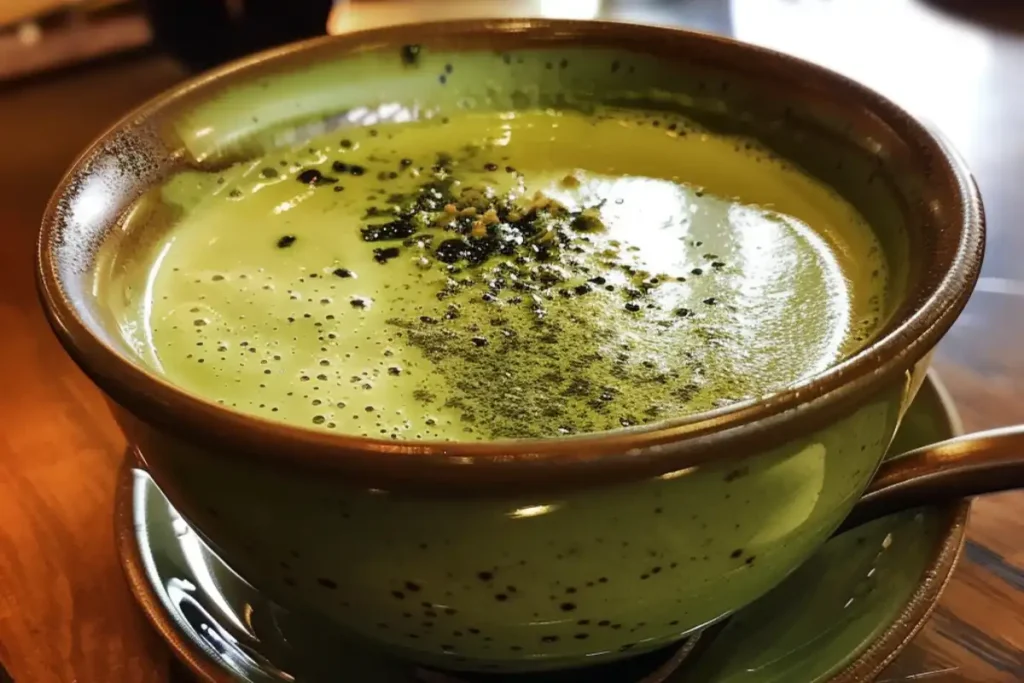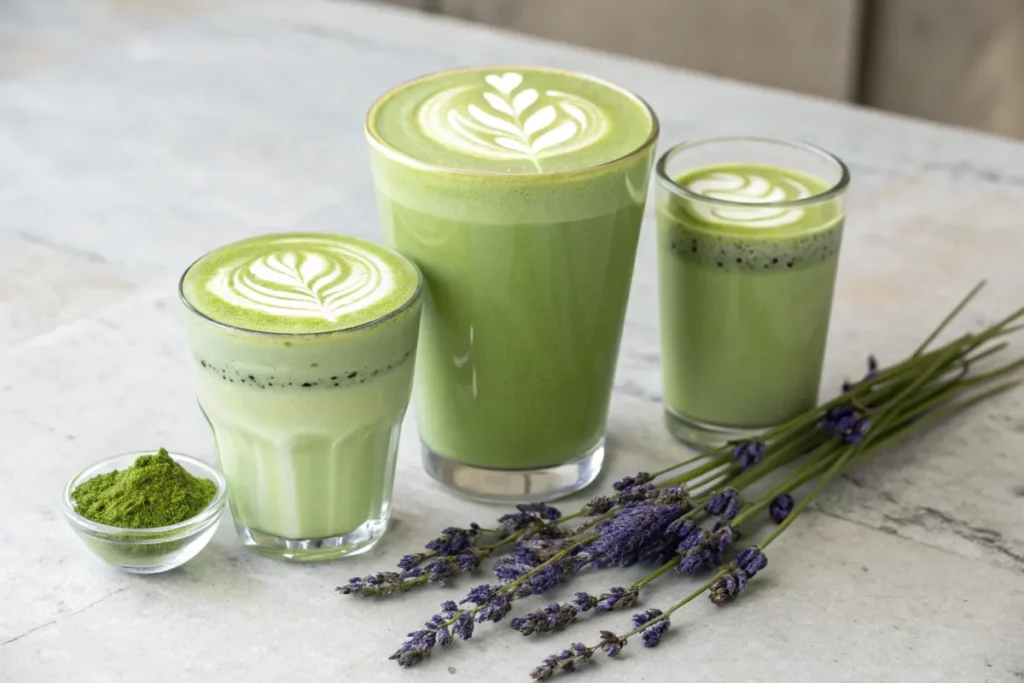The lavender matcha latte has become a popular drink for those seeking a perfect balance between energy and relaxation. The unique combination of earthy matcha and calming lavender makes it an ideal choice for anyone who enjoys the benefits of caffeine without the intensity of coffee. But just how much caffeine in lavender matcha latte does this floral-infused beverage contain?
Understanding the caffeine in lavender matcha latte is crucial for anyone mindful of their daily intake. In this guide, we’ll not only explore its caffeine levels but also how they compare to other beverages. Additionally, we’ll examine the factors that influence the amount of caffeine in your cup
Table of Contents
What is a Lavender Matcha Latte?
A lavender matcha latte is a delightful twist on the classic matcha latte, infused with the floral essence of lavender. The drink is made by whisking matcha powder, a finely ground green tea, into water or steamed milk. The addition of lavender—either as syrup or dried flowers—adds a sweet, floral aroma that softens the sometimes bitter taste of matcha, creating a well-balanced beverage.
This drink is especially loved for its versatility, as it can be enjoyed hot or iced, with dairy or plant-based milk, and sweetened or unsweetened, depending on personal preferences. Beyond the delicious taste, it’s the combination of caffeine in lavender matcha latte that makes it stand out—offering matcha’s mild energy boost alongside lavender’s calming properties for a unique balance of relaxation and alertness
Ingredients of a Lavender Matcha Latte

The beauty of the lavender matcha latte lies in its simplicity. The key ingredients are:
- Matcha Powder: Made from finely ground green tea leaves, matcha is the base of the drink and provides the majority of the caffeine.
- Lavender: Usually added in the form of lavender syrup or steeped dried lavender flowers, this ingredient gives the latte its distinctive floral flavor and aroma.
- Milk: Steamed or frothed milk—whether dairy or non-dairy like oat milk or almond milk—creates a creamy texture.
- Sweetener: Optional, but often added to balance the earthiness of the matcha and enhance the sweetness of the lavender. Honey, agave syrup, or a simple syrup are popular choices.
For those looking to make their own version at home, check out this detailed recipe for Lavender Matcha, which provides step-by-step instructions for the perfect blend of floral and earthy flavors!.
What is Matcha?

At the heart of any lavender matcha latte is matcha, a finely powdered green tea that has been used in Japan for centuries. Unlike traditional tea, where the leaves are steeped and then discarded, matcha allows you to consume the entire tea leaf in powdered form. This not only gives the drink its vibrant green color but also means that it contains more caffeine and nutrients than regular brewed tea.
Types of Matcha
- Ceremonial Grade Matcha: To begin with, this is the highest quality matcha, typically used in traditional Japanese tea ceremonies. It boasts a delicate flavor with a smooth, non-bitter taste. This makes it perfect for drinking on its own or with minimal ingredients
- Culinary Grade Matcha: On the other hand, culinary grade matcha is slightly more bitter. This grade is often used in cooking, baking, and lattes. Its strong flavor pairs well with milk and sweeteners, making it a common choice for lavender matcha lattes.
For more information about matcha and its caffeine content, you can check out this detailed guide on caffeine content in matcha.
The Role of Lavender in a Matcha Latte
While matcha is the star of this latte, lavender elevates the drink even more. Known for its calming properties, lavender adds a sweet, floral flavor while helping to balance the energy boost from matcha. Popular in both aromatherapy and cooking, lavender perfectly complements the earthy, slightly bitter taste of matcha.
Lavender as a Calming Agent
Lavender has long been associated with relaxation and stress relief. When used in a lavender matcha latte, the floral notes help create a more balanced beverage, providing a sense of calm that counteracts any jitters from the caffeine in lavender matcha latte. This makes the drink perfect for those looking to enjoy a caffeine boost without the intensity that sometimes accompanies coffee or energy drinks.
For more on how to incorporate lavender into different beverages, you can explore this recipe for a lavender oat milk latte .
How Much Caffeine is in a Regular Matcha Latte?
Before diving into the specifics of caffeine in lavender matcha latte, it’s important to understand the baseline caffeine content in a regular matcha latte. On average, an 8-ounce serving of matcha latte contains around 60-80 mg of caffeine. This caffeine level can vary depending on factors such as the quality of the matcha and the amount of powder used
Caffeine Comparison with Other Beverages:
- Matcha Latte (8 oz): 60-80 mg of caffeine
- Brewed Coffee (8 oz): 95-165 mg of caffeine
- Green Tea (8 oz): 25-35 mg of caffeine
- Espresso (1 shot): 63 mg of caffeine
While matcha contains less caffeine than a typical cup of coffee, it provides a more sustained and stable energy boost due to the presence of L-theanine, an amino acid that helps the body absorb caffeine more slowly. This makes matcha a great option for those looking for a gentler, longer-lasting form of energy.
For instance, dirty chai is another trendy drink that blends tea and coffee for a bold, flavorful experience. If you're curious about what makes a dirty chai unique, you can check out this guide on What Is a Dirty Chai?.
caffeine in lavender matcha latte by Serving Size

The amount of caffeine in lavender matcha latte depends on several factors. These include the amount of matcha powder used, as well as the size of the serving. To clarify, here’s a breakdown of the estimated caffeine content based on different serving sizes:
Caffeine Content by Serving Size:
- 8 oz (Small): 60-80 mg of caffeine
- 12 oz (Medium): 80-120 mg of caffeine
- 16 oz (Large): 120-160 mg of caffeine
The larger the serving size, the more matcha is typically used, which increases the caffeine in lavender matcha latte. However, it’s important to note that the addition of lavender does not affect the caffeine levels, as lavender contains no caffeine
Factors That Influence the caffeine in lavender matcha latte
Several factors can influence how much caffeine in lavender matcha latte. Here are some key factors that can affect the caffeine content:
1. Quality of Matcha
- Higher-quality ceremonial-grade matcha tends to have slightly more caffeine than lower-quality culinary-grade matcha. If you’re looking for a more potent caffeine boost, opt for premium matcha.
2. Amount of Matcha Used
- The more matcha powder you use, the more caffeine your latte will contain. Most recipes call for about 1-2 teaspoons of matcha, but you can adjust the amount based on your personal caffeine tolerance and preferences.
3. Serving Size
- Larger lattes contain more matcha powder and therefore more caffeine. If you want to reduce your caffeine intake, opt for a smaller serving size.
How Lavender Matcha Compares to Coffee and Green Tea
A lavender matcha latte provides a steady energy boost, falling between green tea and coffee in caffeine content.
- Matcha vs. Green Tea: Regular green tea has 25-35 mg per 8 oz, whereas matcha’s whole-leaf consumption results in higher caffeine levels.
- Matcha vs. Coffee: A 16 oz coffee has 190-330 mg of caffeine, while matcha latte contains 120-160 mg—less intense but longer-lasting.
A lavender matcha latte is a unique drink that offers both energy and relaxation. With caffeine in lavender matcha latte ranging between 60-160 mg, it provides a steady boost without the intensity of coffee. The addition of lavender brings calming effects, making the drink balanced and enjoyable
FAQs About Caffeine in Lavender Matcha Lattes
1. How much caffeine is in a lavender matcha latte from Starbucks?
- A grande (16 oz) lavender matcha latte from Starbucks typically contains 55-70 mg of caffeine, depending on how much matcha is used in the drink.
2. Is lavender matcha better than coffee?
- Ultimately, it depends on your personal preferences and caffeine tolerance. However, lavender matcha offers a more sustained energy boost, without the sharp spikes and crashes typically associated with coffee. Additionally, the calming properties of lavender make it a gentler option.
3. Can you make a lavender matcha latte with decaffeinated matcha?
- While decaffeinated matcha is rare, you can reduce the caffeine by using smaller amounts of matcha powder in your drink.
4. How long does the caffeine boost from a lavender matcha latte last?
- The caffeine in matcha is absorbed more slowly than coffee, providing a steady energy boost that can last 4-6 hours without the sharp crash often associated with coffee.
5. Does lavender reduce the effects of caffeine in matcha?
- The calming properties of lavender can help mitigate some of the stimulating effects of caffeine, creating a more balanced and relaxing experience.

